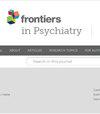Enhanced classification and severity prediction of major depressive disorder using acoustic features and machine learning
IF 3.2
3区 医学
Q2 PSYCHIATRY
引用次数: 0
Abstract
BackgroundPrevious studies have classified major depression and healthy control groups based on vocal acoustic features, but the classification accuracy needs to be improved. Therefore, this study utilized deep learning methods to construct classification and prediction models for major depression and healthy control groups.Methods120 participants aged 16–25 participated in this study, included 64 MDD group and 56 HC group. We used the Covarep open-source algorithm to extract a total of 1200 high-level statistical functions for each sample. In addition, we used Python for correlation analysis, and neural network to establish the model to distinguish whether participants experienced depression, predict the total depression score, and evaluate the effectiveness of the classification and prediction model.ResultsThe classification modelling of the major depression and the healthy control groups by relevant and significant vocal acoustic features was 0.90, and the Receiver Operating Characteristic (ROC) curves analysis results showed that the classification accuracy was 84.16%, the sensitivity was 95.38%, and the specificity was 70.9%. The depression prediction model of speech characteristics showed that the predicted score was closely related to the total score of 17 items of the Hamilton Depression Scale(HAMD-17) (r=0.687, P<0.01); and the Mean Absolute Error(MAE) between the model’s predicted score and total HAMD-17 score was 4.51.LimitationThis study’s results may have been influenced by anxiety comorbidities.ConclusionThe vocal acoustic features can not only effectively classify the major depression and the healthy control groups, but also accurately predict the severity of depressive symptoms.利用声学特征和机器学习加强重度抑郁障碍的分类和严重程度预测
背景以往的研究基于声学特征对重度抑郁症和健康对照组进行了分类,但分类的准确性有待提高。因此,本研究利用深度学习方法构建了重度抑郁症组和健康对照组的分类和预测模型。方法120名16-25岁的参与者参与了本研究,包括64名MDD组和56名HC组。我们使用 Covarep 开源算法为每个样本提取了共计 1200 个高级统计函数。此外,我们还使用 Python 进行了相关性分析,并使用神经网络建立了区分参与者是否患有抑郁症、预测抑郁总分的模型,并对分类和预测模型的有效性进行了评估。结果重度抑郁症组和健康对照组的相关显著声学特征分类模型为 0.90,ROC 曲线分析结果显示,分类准确率为 84.16%,灵敏度为 95.38%,特异性为 70.9%。言语特征抑郁预测模型显示,预测得分与汉密尔顿抑郁量表(HAMD-17)17 项总分密切相关(r=0.687,P<0.01);模型预测得分与 HAMD-17 总分的平均绝对误差(MAE)为 4。51.局限性本研究结果可能受到焦虑合并症的影响。
本文章由计算机程序翻译,如有差异,请以英文原文为准。
求助全文
约1分钟内获得全文
求助全文
来源期刊

Frontiers in Psychiatry
Medicine-Psychiatry and Mental Health
CiteScore
6.20
自引率
8.50%
发文量
2813
审稿时长
14 weeks
期刊介绍:
Frontiers in Psychiatry publishes rigorously peer-reviewed research across a wide spectrum of translational, basic and clinical research. Field Chief Editor Stefan Borgwardt at the University of Basel is supported by an outstanding Editorial Board of international researchers. This multidisciplinary open-access journal is at the forefront of disseminating and communicating scientific knowledge and impactful discoveries to researchers, academics, clinicians and the public worldwide.
The journal''s mission is to use translational approaches to improve therapeutic options for mental illness and consequently to improve patient treatment outcomes.
 求助内容:
求助内容: 应助结果提醒方式:
应助结果提醒方式:


